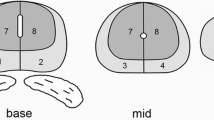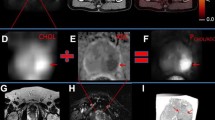Abstract
Purpose
The aim of this study was to determine the usefulness of MRI-assisted positron emission tomography (PET) parameters provided by simultaneous 18F-fluorocholine (FCH) PET/MRI for characterization of primary prostate cancer.
Methods
Thirty patients with localized prostate cancer (mean age 69.4 ± 6.7 years) confirmed by biopsy were prospectively enrolled for simultaneous PET/MRI imaging. The patients underwent 18F-FCH PET/MRI 1 week before undergoing total prostatectomy. Multiple parameters of diffusion-weighted MRI [minimum and mean apparent diffusion coefficient (ADCmin and ADCmean)], metabolic PET [maximum and mean standardized uptake value (SUVmax and SUVmean)], and metabolic volumetric PET [metabolic tumor volume (MTV) and uptake volume product (UVP)] were compared with laboratory, pathologic, and immunohistochemical (IHC) features of the prostate cancer specimen. PET parameters were divided into two categories as follows: volume of interest (VOI) of prostate by SUV cutoff 2.5 (SUVmax, SUVmean, MTVSUV, and UVPSUV) and MRI-assisted VOI of prostate cancer (SUVmaxMRI, SUVmeanMRI, MTVMRI, and UVPMRI).
Results
The rates of prostate cancer-positive cases identified by MRI alone, 18F-FCH PET alone, and 18F-FCH PET/MRI were 83.3, 80.0, and 93.3 %, respectively. Among the multiple PET/MRI parameters, MTVMRI showed fair correlation with serum prostate-specific antigen (PSA; r = 0.442, p = 0.014) and highest correlation with tumor volume (r = 0.953, p < 0.001). UVPMRI showed highest correlation with serum PSA (r = 0.531, p = 0.003), good correlation with tumor volume (r = 0.908, p < 0.001), and it was significantly associated with Gleason score (p = 0.041). High MTVMRI and UVPMRI values were significant for perineural invasion, lymphatic invasion, extracapsular extension, seminal vesicle invasion, and positive B-cell lymphoma 2 (Bcl-2) expression (all p < 0.05).
Conclusion
Simultaneous 18F-FCH PET/MRI demonstrated a better diagnostic value for localized prostate cancer detection than each individual modality. MRI-assisted metabolic volumetric PET parameters (MTVMRI and UVPMRI) provided more accurate characterization of prostate cancer than conventional PET and MRI parameters.




Similar content being viewed by others
References
Siegel R, Naishadham D, Jemal A. Cancer statistics, 2013. CA Cancer J Clin 2013;63:11–30.
Ravizzini G, Turkbey B, Kurdziel K, Choyke PL. New horizons in prostate cancer imaging. Eur J Radiol 2009;70:212–26.
Takahashi N, Inoue T, Lee J, Yamaguchi T, Shizukuishi K. The roles of PET and PET/CT in the diagnosis and management of prostate cancer. Oncology 2007;72:226–33.
Ahmed HU, Kirkham A, Arya M, Illing R, Freeman A, Allen C, et al. Is it time to consider a role for MRI before prostate biopsy? Nat Rev Clin Oncol 2009;6:197–206.
Ghafoori M, Alavi M, Aliyari Ghasabeth M. MRI in prostate cancer. Iran Red Crescent Med J 2013;15:e16620.
Jadvar H. Molecular imaging of prostate cancer: PET radiotracers. AJR Am J Roentgenol 2012;199:278–91.
Jadvar H. Molecular imaging of prostate cancer with PET. J Nucl Med 2013;54:1685–8.
Hong H, Zhang Y, Sun J, Cai W. Positron emission tomography imaging of prostate cancer. Amino Acids 2010;39:11–27.
Evangelista L, Zattoni F, Guttilla A, Saladini G, Zattoni F, Colletti PM, et al. Choline PET or PET/CT and biochemical relapse of prostate cancer: a systematic review and meta-analysis. Clin Nucl Med 2013;38:305–14.
Krause BJ, Souvatzoglou M, Treiber U. Imaging of prostate cancer with PET/CT and radioactively labeled choline derivates. Urol Oncol 2013;31:427–35.
Sauter AW, Wehrl HF, Kolb A, Judenhofer MS, Pichler BJ. Combined PET/MRI: one step further in multimodality imaging. Trends Mol Med 2010;16:508–15.
Pace L, Nicolai E, Aiello M, Catalano OA, Salvatore M. Whole-body PET/MRI in oncology: current status and clinical applications. Clin Transl Imaging 2013;1:31–44.
Lee SJ, Seo HJ, Cheon GJ, Kim JH, Kim EE, Kang KW, et al. Usefulness of integrated PET/MRI in head and neck cancer: a preliminary study. Nucl Med Mol Imaging 2014;48:98–105.
Wetter A, Lipponer C, Nensa F, Beiderwellen K, Olbricht T, Rübben H, et al. Simultaneous 18F choline positron emission tomography/magnetic resonance imaging of the prostate: initial results. Invest Radiol 2013;48:256–62.
Wetter A, Lipponer C, Nensa F, Heusch P, Rübben H, Altenbernd JC, et al. Evaluation of the PET component of simultaneous [(18)F]choline PET/MRI in prostate cancer: comparison with [(18)F]choline PET/CT. Eur J Nucl Med Mol Imaging 2014;41:79–88.
Chang JH, Lim Joon D, Lee ST, Hiew CY, Esler S, Gong SJ, et al. Diffusion-weighted MRI, 11C-choline PET and 18F-fluorodeoxyglucose PET for predicting the Gleason score in prostate carcinoma. Eur Radiol 2014;24:715–22.
Wetter A, Lipponer C, Nensa F, Heusch P, Rübben H, Schlosser TW, et al. Quantitative evaluation of bone metastases from prostate cancer with simultaneous [18F] choline PET/MRI: combined SUV and ADC analysis. Ann Nucl Med 2014;28:405–10.
Yoneyama T, Tateishi U, Terauchi T, Inoue T. Correlation of metabolic tumor volume and 11C-choline uptake with the pathology of prostate cancer: evaluation by use of simultaneously recorded MR and PET images. Jpn J Radiol 2014;32:155–63.
Rahim MK, Kim SE, So H, Kim HJ, Cheon GJ, Lee ES, et al. Recent trends in PET image interpretations using volumetric and texture-based quantification methods in nuclear oncology. Nucl Med Mol Imaging 2014;48:1–15.
Euhus DM, Hudd C, LaRegina MC, Johnson FE. Tumor measurement in the nude mouse. J Surg Oncol 1986;31:229–34.
von Eyben FE, Kairemo K. Meta-analysis of (11)C-choline and (18)F-choline PET/CT for management of patients with prostate cancer. Nucl Med Commun 2014;35:221–30.
Fuccio C, Rubello D, Castellucci P, Marzola MC, Fanti S. Choline PET/CT for prostate cancer: main clinical applications. Eur J Radiol 2011;80:e50–6.
Schwarzenböck S, Souvatzoglou M, Krause BJ. Choline PET and PET/CT in primary diagnosis and staging of prostate cancer. Theranostics 2012;2:318–30.
Lütje S, Boerman OC, van Rij CM, Sedelaar M, Helfrich W, Oyen WJ, et al. Prospects in radionuclide imaging of prostate cancer. Prostate 2012;72:1262–72.
Romesser PB, Lim R, Spratt DE, Setton J, Riaz N, Lok B, et al. The relative prognostic utility of standardized uptake value, gross tumor volume, and metabolic tumor volume in oropharyngeal cancer patients treated with platinum based concurrent chemoradiation with a pre-treatment [(18)F] fluorodeoxyglucose positron emission tomography scan. Oral Oncol 2014;50:802–8.
Kim YI, Cheon GJ, Paeng JC, Cho JY, Kang KW, Chung JK, et al. Total lesion glycolysis as the best 18F-FDG PET/CT parameter in differentiating intermediate–high risk adrenal incidentaloma. Nucl Med Commun 2014;35:606–12.
Chung HH, Lee I, Kim HS, Kim JW, Park NH, Song YS, et al. Prognostic value of preoperative metabolic tumor volume measured by 18F-FDG PET/CT and MRI in patients with endometrial cancer. Gynecol Oncol 2013;130:446–51.
Byun BH, Noh WC, Lim I, Lee SS, Cho AR, Park JA, et al. A new method for apparent diffusion coefficient measurement using sequential (18)F-FDG PET and MRI: correlation with histological grade of invasive ductal carcinoma of the breast. Ann Nucl Med 2013;27:720–8.
Bundschuh RA, Wendl CM, Weirich G, Eiber M, Souvatzoglou M, Treiber U, et al. Tumour volume delineation in prostate cancer assessed by [11C]choline PET/CT: validation with surgical specimens. Eur J Nucl Med Mol Imaging 2013;40:824–31.
Schwarzenböck SM, Kurth J, Gocke C, Kuhnt T, Hildebrandt G, Krause BJ. Role of choline PET/CT in guiding target volume delineation for irradiation of prostate cancer. Eur J Nucl Med Mol Imaging 2013;40:S28–35.
Epstein JI, Allsbrook Jr WC, Amin MB, Egevad LL, ISUP Grading Committee. The 2005 International Society of Urological Pathology (ISUP) consensus conference on Gleason grading of prostatic carcinoma. Am J Surg Pathol 2005;29:1228–42.
Beheshti M, Imamovic L, Broinger G, Vali R, Waldenberger P, Stoiber F, et al. 18F choline PET/CT in the preoperative staging of prostate cancer in patients with intermediate or high risk of extracapsular disease: a prospective study of 130 patients. Radiology 2010;254:925–33.
Kitajima K, Murphy RC, Nathan MA. Choline PET/CT for imaging prostate cancer: an update. Ann Nucl Med 2013;27:581–91.
Moul JW. Angiogenesis, p53, bcl-2 and Ki-67 in the progression of prostate cancer after radical prostatectomy. Eur Urol 1999;35(5–6):399–407.
Breeuwsma AJ, Pruim J, Jongen MM, Suurmeijer AJ, Vaalburg W, Nijman RJ, et al. In vivo uptake of [11C]choline does not correlate with cell proliferation in human prostate cancer. Eur J Nucl Med Mol Imaging 2005;32:668–73.
Acknowledgments
This study was supported by grants of the Korea Health Technology R&D Project through the Korea Health Industry Development Institute (KHIDI), funded by the Ministry of Health & Welfare, Republic of Korea (grant number: HI07C0001 & HI14C1072).
Compliance with ethical standards
ᅟ
Conflicts of interest
None.
Ethical approval
All procedures performed in studies involving human participants were in accordance with the ethical standards of the Institutional Research Committee and with the 1964 Declaration of Helsinki and its later amendments or comparable ethical standards.
Informed consent
Informed consent was obtained from all individual participants included in the study.
Author information
Authors and Affiliations
Corresponding authors
Rights and permissions
About this article
Cite this article
Kim, Yi., Cheon, G.J., Paeng, J.C. et al. Usefulness of MRI-assisted metabolic volumetric parameters provided by simultaneous 18F-fluorocholine PET/MRI for primary prostate cancer characterization. Eur J Nucl Med Mol Imaging 42, 1247–1256 (2015). https://doi.org/10.1007/s00259-015-3026-5
Received:
Accepted:
Published:
Issue Date:
DOI: https://doi.org/10.1007/s00259-015-3026-5




